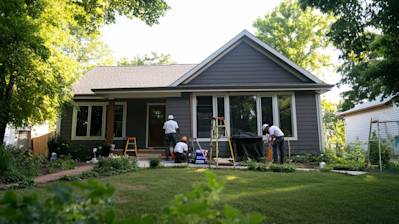Faux stone siding, often referred to as stone veneer, is gaining tremendous popularity in modern home and commercial property designs. Boasting affordability, design versatility, ease of installation, and durability, faux stone siding delivers unmatched benefits that surpass even natural stone siding. This article will illuminate everything you need to know about faux stone siding, revolutionizing your outlook on this highly sought-after architectural feature.
Understanding Faux Stone Siding
So, what exactly is faux stone siding? This exterior and interior finishing solution ingeniously mimics the appearance of natural stone while being manufactured from cement composite, polyurethane or other synthetic materials. These panels are cast in molds made from real stone, making it nearly impossible to differentiate faux stone siding from natural stone.
The Incredible Aesthetic Appeal of Faux Stone Siding
One of the main reasons homeowners and property developers are swayed towards faux stone siding is the incredible aesthetic appeal it brings to any structure. Faux stone panels come in an array of shapes, colors, and textures, making them a designer's dream. The ability to mix and match different profiles and colors adds a unique personalized touch to any building.
The versatility of faux stone siding allows for various applications including:
- Home exteriors
- Interior walls
- Fireplace surrounds
- Kitchen islands
The list of possible applications of faux stone siding is practically limitless, allowing for flexibility across diverse design landscapes.
Environmental Responsibility with Faux Stone Siding
Faux stone siding should be the go-to choice for environmentally conscious property owners. These panels spare our natural resources by using a fraction of the stone used in traditional sidings. Additionally, the manufacturing process is less energy-intensive, resulting in a smaller carbon footprint.
The Versatile Nature of Faux Stone Siding
Faux stone siding enables property owners to bring their design dreams to fruition without breaking the bank. Because they come in lightweight panels, faux stone sidings are easy to handle during the installation process.
Moreover, these synthetic panels can be applied over existing brick or wood siding, further reducing labor costs.
Practical Advantages of Faux Stone Siding
Aside from the aesthetic and environmental benefits, faux stone siding also comes with several practical advantages.
Durability: Despite being lightweight, faux stone siding Molds are resistant to chipping, cracking, and fading. They can withstand harsh weather conditions, including intense UV radiation, without losing their aesthetic appeal.
Maintenance: Faux stone sidings require minimal maintenance. A simple hose down is often enough to keep them looking fresh and new. Furthermore, they're resistant to pests, molds, and moisture, eliminating the need for constant inspections.
Insulation: Faux stone siding adds an extra layer of insulation to your home, helping you control heating and cooling costs effectively.
The Installation Process – Easier Than You Think
With faux stone siding, the installation process is quick, easy, and hassle-free. The lightweight nature of faux stone panels makes them easy to maneuver, while their design aids in quick installation. A professional can install large amounts of faux stone siding in a single day.
However, if you're a handy homeowner, you could also undertake a DIY project using faux stone siding. Most manufacturers provide comprehensive installation guides, making the process accessible even for amateur handymen.
Investing in Faux Stone Siding
Elevating the appeal of your home or business no longer requires an extravagant budget. With faux stone siding, you can transform any space into a work of art while keeping costs down.
Moreover, the durability and ease of maintenance of faux stone siding mean you won't constantly pour money into maintenance, repairs, or replacements.
Why not invest in faux stone siding and explore the limitless potential it adds to your architectural designs? With its unique blend of aesthetic appeal, environmental friendliness, versatility, and convenience, faux stone siding guarantees an impressive return on your investment.

Frequently Asked Questions about Faux Stone Siding
How does Real Stone Siding and Faux Stone Siding Differ?
The main differences between real stone and faux stone siding lie in their cost, installation processes, and weight. Real stone is weighty, needing footings for installation, and is expensive. Faux stone siding, on the other hand, is lightweight, less expensive, and requires less labor-intensive installation.
Is Faux Stone Siding Considered Energy-Efficient?
Faux stone siding can improve the insulation of your home, making it more energy-efficient, depending on the type used. Some faux stone siding comes with insulation sandwiched between the siding and your home. By adding an extra layer of insulation to your home, it can help reduce both heating and cooling costs.
Is Faux Stone Siding Durable?
Faux stone siding is built for durability. Its design resists fading, chipping, and cracking, providing the charm of real stone without the associated upkeep. However, just like any other siding material, faux stone siding requires proper installation and occasional cleaning to ensure its longevity.
How is Faux Stone Siding Installed?
Most faux stone siding projects begin with a flat and clean wall surface. Depending on the product, you may need to add a layer of waterproof barrier or sheathing. The faux stone siding pieces are stacked one atop the other and adhered with a type of construction adhesive. Remember that installation instructions may vary between products, so always refer to manufacturer instructions.
What Maintenance Does Faux Stone Siding Require?
Faux stone siding requires minimal maintenance. Generally, an annual cleaning using a low-pressure hose and a soft brush is sufficient to keep the siding looking its best. If a panel is damaged, it can usually be replaced without disrupting the entire façade.
Can Faux Stone Siding be Installed on Existing Walls?
Yes, it is possible to install faux stone siding over existing walls. However, preparation is key for successful siding installation. Depending on the type of existing wall material on your house, you may need specific preparation methods to ensure a good bond.
What Types of Faux Stone Siding are Available?
There are many types of faux stone siding available, imitating various kinds of stones like limestone, granite, and river rock. These also come in different styles, like ledgestone, cobblestone, and fieldstone. You can also find faux stone siding in many color options, offering you the freedom to choose the perfect siding style that matches the aesthetic of your home.
Does Faux Stone Siding add Value to a Home?
Faux stone siding can indeed add value to a home. Aside from enhancing your home’s curb appeal due to its attractive finish, its durability, low maintenance needs, and insulation properties can be attractive aspects to potential buyers.

Pros of Faux Stone Siding
Lower Cost
One of the top advantages of faux stone siding is its cost-effectiveness. Traditional stone sidings can come with a hefty price tag due both to the cost of materials and the labor-intensive installation process. In contrast, faux stone siding is created from synthetic materials, significantly reducing manufacturing costs which are passed on as savings to the consumer.
Easy Installation
Faux stone siding is considerably lighter than its natural stone counterpart. This stark contrast in weight simplifies the logistics of transportation and installation. Work can often be completed faster than with traditional stone which can reduce labor costs as well.
Variety of Styles and Colors
Because faux stone siding is manufactured, it has a vast range of available styles and colors. This variety makes it easier to match your siding with other elements of your home, such as roofing or landscaping, giving you greater control over your property's aesthetic.
Durability
Despite being lightweight, faux stone siding is designed for durability. It is resistant to insect damage, unlike some other siding types, and stands up well to the elements, including sun and rain. These features can lead to a longer lifespan, meaning less maintenance and repair costs in the long term.
Eco-Friendly
Manufacturers of faux stone siding often use recycled materials in production, making this a more eco-friendly alternative to traditional stone siding, which requires the extraction and processing of raw materials.
Cons of Faux Stone Siding
Lower Resale Value
While faux stone siding might look similar to real stone, one substantial disadvantage is that it can lower the resale value of your home. Real stone has a timeless beauty and durability that tends to increase a property’s value more than its faux stone counterparts.
Lack of Authenticity
Even though advances in manufacturing technology have made significant strides in the realism of faux stone siding, it still doesn't have the authentic feel of natural stone. Up close, people can usually differentiate between the two.
Performance Under Extreme Conditions
Compared to natural stone, faux stone siding could show signs of damage after prolonged exposure to extreme weather conditions. High heat from fires or intense sunlight can cause the siding to warp or fade. Additionally, in very cold climates, the freeze-thaw cycle can cause cracks or other damage.
Can Look Artificial
While there's a variety of styles and colors to choose from, some may argue that certain patterns and shades look artificial. This could detract from the natural look and feel that one might be aiming for when choosing stone siding.
Repairs can be Difficult
More than often, faux stone siding is installed in large panels rather than individual stones. This can pose a problem when it comes to repairs. If a small section of the siding is damaged, you may have to replace the entire panel rather than just fixing a single stone.

Myths and Misconceptions about Faux Stone Siding
Myth 1: Faux Stone Siding Looks Unnatural and Fake
Why people believe this
A common misconception about faux stone siding is that it looks cheap and obviously not like real stone. This probably stems from older versions of synthetic materials, which often lacked the variety and detail seen in natural materials.
The truth
Modern manufacturing processes have advanced considerably in recent years. Today's faux stone siding can mimic the look of natural stone so closely that it's often difficult to tell the difference. Manufacturers have also expanded their color range and now offer a wider variety of textures and finishes.
Moreover, given that real stone comes with natural imperfections, the imperfections included in the design of faux stones actually make them look more authentic.
Myth 2: Faux Stone Siding Has Low Durability
Why people believe this
Many people infer that because faux stone siding uses synthetic materials, it’s not as durable as real stone.
The truth
While natural stone is indeed very durable, it's not invincible. It can chip, break, and experience weather damage. Faux stone siding, on the other hand, is designed to withstand a wide range of weather conditions without showing signs of wear.
In fact, faux stone siding is often less susceptible to damage, such as chipping or discoloration, than natural stone. Moreover, many types of faux stone siding are treated with UV inhibitors, which further increase their durability and longevity.
Myth 3: Faux Stone Siding Reduces Property Value
Why people believe this
Some people believe that because faux stone siding is cheaper than real stone, it will make a home look cheaper and thus lower its property value.
The truth
The value of a property is determined by numerous factors, not just one aspect of exterior decor. While high-quality materials can certainly improve curb appeal and potentially increase value, whether or not that material is real stone isn't as crucial.
What's more, a well-maintained home with faux stone siding could very well command a higher value than a neglected home with real stone. It's also worth noting that if the faux stone siding is good quality and installed correctly, it could actually boost property value due to its low maintenance and durable nature.
Myth 4: Faux Stone Siding is Bad for the Environment
Why people believe this
A lot of people believe that because faux stone is a man-made product, its production must have a negative impact on the environment.
The truth
While all manufacturing processes have environmental impacts, many manufacturers of faux stone siding have taken steps to reduce their carbon footprints. This is done through energy-efficient production processes, recycling waste materials, and sometimes even incorporating recycled materials into the products themselves.
Additionally, because faux stone siding requires less maintenance and lasts longer than many other siding materials, its overall environmental impact can be less.
Myth 5: Faux Stone Siding is Difficult to Install
Why people believe this
Installing any type of siding could be considered difficult if you have no experience doing so. Therefore, some people carry the misconception that faux stone siding, because of its intricate design, is exceptionally difficult to install.
The truth
Professional installation is always recommended to guarantee the best results. However, the design of faux stone panels often includes features that simplify the installation process. The panels usually fit together easily, like puzzle pieces, and many types have a backing that can be screwed straight onto wall sheathing, with no need for a mortar and a mesh wall like real stone.
While it's not a beginner DIY project, a handy homeowner could certainly manage the installation of faux stone siding with a bit of research and patience. Whether you choose to DIY or hire a professional, it's definitely not insurmountably difficult to install.
Summary
Faux stone siding has stormed the home improvement sector. Its position as the go-to solution for homeowners looking to get that stone finish look at a fraction of the cost without compromising the natural stone appearance is unbeatable. The durability is a definite check, weather resistance too, truly a low-maintenance option. With an array of selections to choose from, finding the right fit for every style isn't a challenge.
The installation of faux stone siding has made the whole home-makeover process much more bearable. The kind of ease seen during application isn't found with real stone. No need for heavy machinery or long construction periods, homeowners can even opt for the DIY route. Not forgetting about the aesthetic value it adds to your home, it's a guaranteed way to uplift the exterior of your living space.
Since it is made from recyclable materials, faux stone siding contributes to environmental conservation. Compared to real stone mining, which contributes to environmental degradation, it's certainly the eco-friendlier option. This is definitely a step in the right direction. It not only allows you to improve your home, but also to preserve Mother Nature. The environmental consciousness and cost-effectiveness it brings to the table is hard to ignore.
About Solid Construction & Design
Solid Construction & Design is a top-rated, locally-operated company based in Sacramento, CA, renowned for our dedication to delivering impressive home renovation and construction services. With a passionate team of skilled professionals on board, we transform spaces into beautifully designed and functionally efficient environments, one project at a time. What sets us apart is not just our outstanding craftsmanship and attention to detail, but also our unwavering commitment to offering personalized customer service. We listen, we care, and we add value to your property like no other. We're not just here to build houses, we're here to redefine your living experience!








